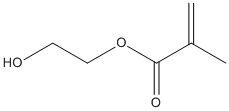HEMA
General
Type : Ring opening polymerization substrate || Acrylate
Chemical_Nomenclature : 2-hydroxyethyl 2-methylprop-2-enoate
Canonical SMILES : CC(=C)C(=O)OCCO
InChI : InChI=1S\/C6H10O3\/c1-5(2)6(8)9-4-3-7\/h7H,1,3-4H2,2H3
InChIKey : WOBHKFSMXKNTIM-UHFFFAOYSA-N
Other name(s) : 2-Hydroxyethyl methacrylate, Glycol methacrylate, Hydroxyethyl methacrylate, Glycol monomethacrylate, CHEBI:53709, ZINC1608929, CHEMBL1730239, SCHEMBL14886

Target
Families : Canar_LipB
References (2)
| Title : Systematic comparison of HEA and HEMA as initiators in enzymatic ring-opening polymerizations - Xiao_2009_Macromol.Biosci_9_713 |
| Author(s) : Xiao Y , Takwa M , Hult K , Koning CE , Heise A , Martinelle M |
| Ref : Macromol Biosci , 9 :713 , 2009 |
| Abstract : Xiao_2009_Macromol.Biosci_9_713 |
| ESTHER : Xiao_2009_Macromol.Biosci_9_713 |
| PubMedSearch : Xiao_2009_Macromol.Biosci_9_713 |
| PubMedID: 19242919 |
| Gene_locus related to this paper: canar-LipB |
| Title : Lipase catalyzed HEMA initiated ring-opening polymerization: in situ formation of mixed polyester methacrylates by transesterification - Takwa_2008_Biomacromolecules_9_704 |
| Author(s) : Takwa M , Xiao Y , Simpson N , Malmstrom E , Hult K , Koning CE , Heise A , Martinelle M |
| Ref : Biomacromolecules , 9 :704 , 2008 |
| Abstract : Takwa_2008_Biomacromolecules_9_704 |
| ESTHER : Takwa_2008_Biomacromolecules_9_704 |
| PubMedSearch : Takwa_2008_Biomacromolecules_9_704 |
| PubMedID: 18198845 |
| Gene_locus related to this paper: canar-LipB |